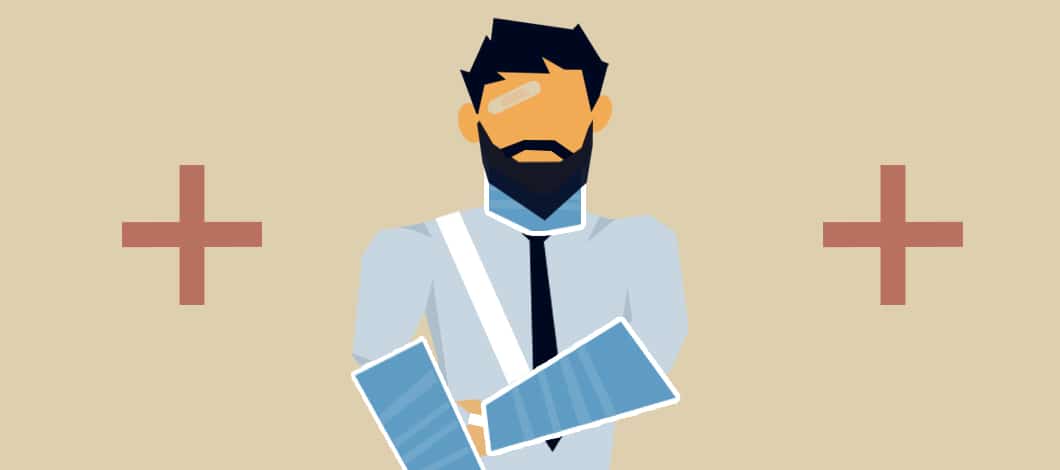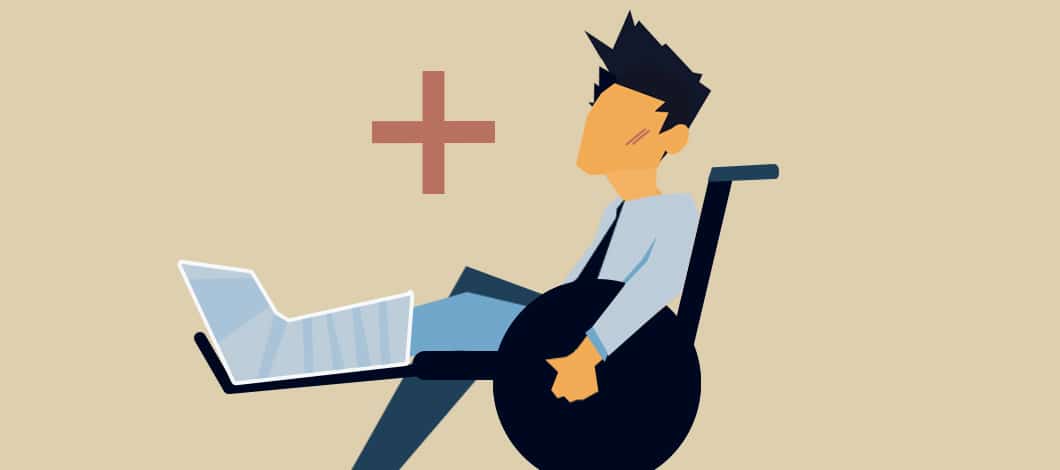Business disability insurance can sustain income when you or your employees are unable to work.
Learn what it is and how it works.
What Is Employer Disability Insurance?
Employer disability insurance is a type of insurance that protects your personal or business income when you or another key personnel are unable to work because of an injury or illness which occurs outside the workplace. If you’re a small business with only a few major employees, the effects of this type of situation could be catastrophic. You might have to shut down your operations or even close your business. Meanwhile, your personal income could be significantly reduced or cut off.
Disability insurance is designed to protect you in this situation. It provides a covered business owner or employees with a percentage of lost income. Some policies also can provide you with funds to cover business expenses or business debt repayment obligations.
What Types of Disability Insurance Are There?
There are several types of disability insurance business owners can get. The most common types are:
- Short-term disability insurance
- Long-term disability insurance
You also can get other specialized types of disability insurance, such as Social Security disability insurance, mortgage disability insurance, supplemental disability insurance and business overhead expense disability insurance. Worker compensation insurance and key person life insurance are related but distinct categories of insurance.
Short-Term Disability
Short-term disability for small business owners is designed to replace income for the policyholder for a relatively short period, typically between 3 months and a year. This type of policy will normally provide up to about 80% of gross monthly income.
As with other types of disability insurance, benefits don’t begin paying out until the expiration of a waiting period, known as an elimination period. With short-term policies, the waiting period may be about 2 weeks. Having shorter waiting periods than long-term policies, short-term policies can be used to provide income while waiting for the elimination period of a long-term policy to expire.
The cost of a short-term disability policy is typically equivalent to about 1% to 3% of gross annual income. Group plans may offer lower rates than individual plans. Some states offer their own short-term disability policies and require employers or employees to purchase them.
Long-Term Disability
Long-term disability insurance typically covers anywhere from 2 years up to the life of the employee, depending on the policy. A long-term policy may replace up to 60% of gross monthly income. The elimination period may be 90 days or more. Cost is about the same as short-term disability, typically 1% to 3% of gross annual income. The longer the term covered by the policy, the higher the premium.
Long-term disability policies can have different qualifying criteria to receive benefits. Some policies provide benefits if you’re unable to do your regular job (own occupation policies), while others only provide benefits if you’re unable to do any type of job (any occupation policies). Some own occupation policies stop paying benefits if you take on a different job (own occupation, not engaged), while others provide benefits while you’re transitioning to another job (transitional own occupation.)
Small business owners and independent contracts applying for long-term disability policies may need to fulfill additional qualifying criteria beyond that of regular wage earners before being accepted as policyholders. Typically, you will need to demonstrate 2 years of profitability by showing tax returns.

Social Security Disability Insurance
Another type of disability insurance is Social Security disability insurance (SSDI). Under this type of insurance, the Social Security Administration provides workers who are totally unable to work for at least a year with monthly payments to the policyholder as well as their spouse and children. The average monthly payment in December 2020 was $1,277.05. Each family member may be eligible for up to 50% of disability benefit amount, with a total cap per family of 150% to 180% of the amount depending on the amount and the number of family members.
SSDS is free, but qualifying for it is difficult. To qualify for SSDI, you must have worked for a sufficient period of time in a job covered by Social Security, and you must meet Social Security’s definition of disability. This means that you must be able to prove that you are unable to do both your previous job as well as any other type of work for at least a year. Self-employed persons are eligible for an SSDI policy just as other employees are.
The average claim takes 5 months to get approval. You do not become eligible for payments until after your first six months of disability.
Mortgage Disability Insurance
Mortgage disability insurance is a specialized type of disability insurance that specifically pays your mortgage if you become disabled. It can be purchased as a standalone policy or as part of a broader life insurance policy called a mortgage protection insurance policy which covers your mortgage bills if you die.
Coverage extends up to a certain amount per month for the term of the policy, and decreases as you pay off your mortgage. Rates are based on factors such as mortgage amount, age, health and occupational risk.
Supplemental Disability Insurance
Supplemental disability insurance is another specialized type of disability insurance designed to cover gaps between your needs and what your long-term disability policy provides.
It can be helpful if your long-term policy doesn’t pay enough, if its duration is too short, if you don’t qualify because you’re able to do other types of work besides your previous job. It also can be useful if you’re receiving SSDI payments which cut into your long-term payment amounts or if you lose your long-term policy because you switch jobs.
Business Overhead Expense Disability Insurance
Business overhead expense (BOE) disability insurance, also known as disability overhead expense insurance, specifically covers overhead expenses, such as employee salaries, payroll expenses and rent.
It doesn’t normally cover the employer’s own salary and personal expenses, unless bundled with another type of disability policy that explicitly does so.
Disability Insurance vs. Worker Compensation Insurance
Disability insurance differs from worker compensation insurance in that it covers income lost because of illnesses and injuries which occur outside the workplace.
Worker compensation applies to work-related illnesses and injuries. In this way, disability insurance fills gaps in workers’ compensation insurance policies.
Key Person Disability Insurance vs. Key Person Life Insurance
One other item we should cover in this disability insurance overview is the difference between disability insurance for key people in your business and a related type of insurance known as key person insurance.
As with disability insurance, key person insurance covers you when major personnel at your company can no longer work. However, it is primarily a form of life insurance in the event a key person dies. A key-person policy may or may not include disability insurance. If you’re considering or carrying key person insurance, make sure you check the details of your policy to see exactly what is covered.
When Do You Need Disability Insurance?
Disability insurance is generally a prudent measure against illnesses and injuries, which can strike any business owner or employee. One-fourth of 20-year-olds will become disabled for an average of 34.6 months before they retire, owing to causes such as back injuries, cancer and heart attacks, according to the Council for Disability Awareness.
Disability insurance is particularly important when:
- You have few other financial resources to fall back upon in the event of serious illness or injury
- You are the sole provider for your family
- Your business operations depend on a small number of key personnel
- You employ women who may become pregnant and would benefit from short-term disability coverage
- You want to offer a competitive benefits package to attract top talent
For maximum coverage, the best strategy is to carry both short-term and long-term disability insurance for you and your employees. If you can’t afford both, long-term disability insurance should be prioritized for protection against illnesses and injuries which can have more catastrophic financial effects. However, your state may require you to provide short-term disability insurance.
Note certain industries may not be eligible to offer voluntary disability policies to employees. Ask your insurance agent, broker or provider for details.

Is Disability Insurance Required?
Employers must carry short-term disability insurance in certain states and territories:
- California
- Hawaii
- New Jersey
- New York
- Rhode Island
- Puerto Rico
State-provided policies generally pay benefits for a maximum of 1 year. They can’t be purchased through a broker. They are generally paid for by the employer, out of employee payroll deductions or a combination of both.
What Should You Look for in a Disability Insurance Policy?
When considering disability insurance policies, there are a number of factors you should consider:
- What type of policy is it?
- How much does it pay in benefits?
- How long is the elimination period?
- How much does it cost?
- How much will costs rise with inflation?
- What are the qualifying criteria to receive benefits (such as own occupation versus any occupation)?
- How will benefits be affected if the policyholder accepts part-time work?
- Are there any provisions requiring the policyholder to help find a replacement to do their work?
Consider these factors in light of your needs and those of your employees.
Protect Your Business From Financial Disruption
Disability insurance protects income and helps cover expenses in the event the policyholder can’t work because of illness or injury encountered outside the workplace. This fills a gap left by worker compensation insurance, which only covers work-related illness and injury.
In some states, employers may be required to carry short-term disability insurance as well as worker compensation insurance. Some policies cover business overhead costs in addition to individual income loss.
Getting disability insurance can provide you with an important safeguard against financial disruption to your business and personal income. If you need cash to manage a crisis, other small business financing options also may help, such as tapping into a business line of credit. If you require financing, take a few minutes to fill out our simple no-obligation online application and find out what types of options may be available to you.










